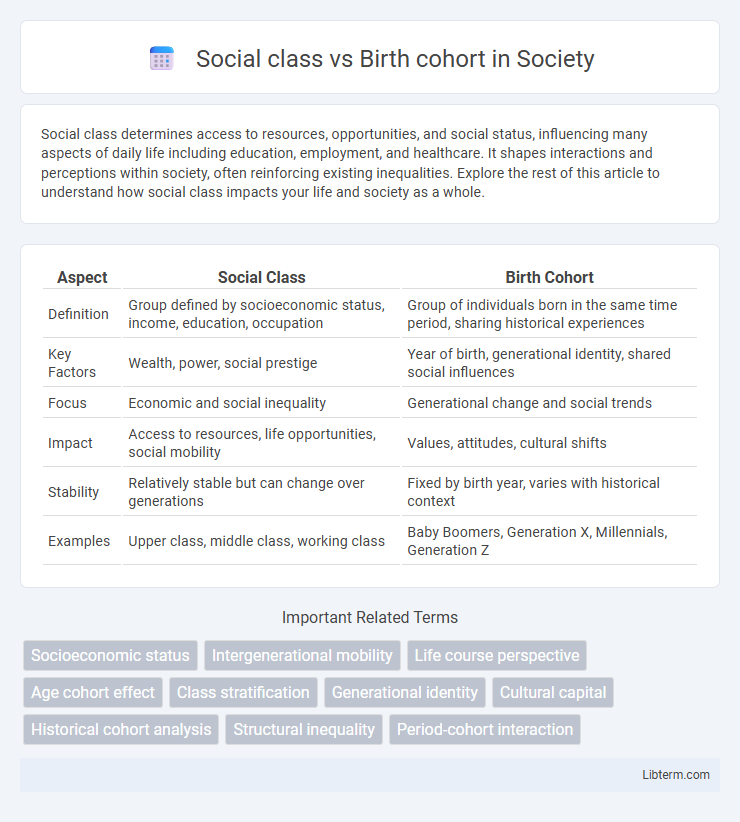Social class determines access to resources, opportunities, and social status, influencing many aspects of daily life including education, employment, and healthcare. It shapes interactions and perceptions within society, often reinforcing existing inequalities. Explore the rest of this article to understand how social class impacts your life and society as a whole.
Table of Comparison
| Aspect | Social Class | Birth Cohort |
|---|---|---|
| Definition | Group defined by socioeconomic status, income, education, occupation | Group of individuals born in the same time period, sharing historical experiences |
| Key Factors | Wealth, power, social prestige | Year of birth, generational identity, shared social influences |
| Focus | Economic and social inequality | Generational change and social trends |
| Impact | Access to resources, life opportunities, social mobility | Values, attitudes, cultural shifts |
| Stability | Relatively stable but can change over generations | Fixed by birth year, varies with historical context |
| Examples | Upper class, middle class, working class | Baby Boomers, Generation X, Millennials, Generation Z |
Defining Social Class and Birth Cohort
Social class refers to a group of individuals sharing similar economic positions, education levels, and occupational status, which influence their lifestyle and opportunities. Birth cohort denotes a group of people born during the same time period, experiencing similar historical and social events impacting their attitudes and behaviors. Understanding social class and birth cohort helps analyze how socioeconomic factors and generational experiences shape individuals' life outcomes.
Historical Evolution of Social Class
The historical evolution of social class reveals significant shifts in stratification influenced by industrialization, urbanization, and economic transformations over birth cohorts. Early agrarian societies maintained rigid class structures based on land ownership, while industrial revolutions introduced new social classes such as the bourgeoisie and proletariat, altering traditional class dynamics across generations. These changes highlight how historical context shapes social mobility and class identities within different birth cohorts.
Understanding Birth Cohorts and Generational Labels
Understanding birth cohorts involves analyzing groups of individuals born during the same period who share formative experiences influencing their attitudes and behaviors. Generational labels such as Baby Boomers, Generation X, Millennials, and Generation Z help categorize these cohorts, highlighting distinct social, economic, and cultural conditions that shape their collective identity. Social class intersects with birth cohorts by affecting access to resources, education, and opportunities, which further differentiates experiences within generational groups.
Key Differences Between Social Class and Birth Cohort
Social class refers to a person's economic and social position based on factors like income, education, and occupation, whereas birth cohort groups individuals born during the same period sharing similar historical experiences. Social class impacts access to resources and life opportunities, influencing social mobility, while birth cohorts shape attitudes, values, and behaviors shaped by the cultural and political events of their formative years. The key difference lies in social class being a structural status affecting socioeconomic outcomes, while birth cohort reflects temporal and cultural generation effects shaping collective identity.
Social Mobility Across Birth Cohorts
Social mobility across birth cohorts reveals significant shifts in socioeconomic status influenced by factors like education, economic opportunities, and policy changes. Studies show that later cohorts tend to experience greater upward mobility compared to earlier ones, driven by expanded access to higher education and evolving labor markets. Persistent inequalities remain, however, as social class origins continue to affect long-term economic outcomes despite generational progress.
Economic Outcomes: Social Class vs Generation
Economic outcomes vary significantly between social classes and birth cohorts, with wealth accumulation and income growth strongly influenced by one's social class originating from family background and education level. Each generation faces distinct economic environments, such as job market shifts and inflation rates, shaping the opportunities and challenges experienced by different birth cohorts. Research highlights that while social mobility can affect outcomes, the interaction between social class and generational factors continues to produce persistent disparities in economic status across lifespans.
Education and Opportunity: A Comparative Perspective
Social class significantly influences educational attainment and career opportunities, with higher social strata typically accessing better resources and networks that facilitate academic success and upward mobility. Birth cohorts experience different societal conditions, such as economic shifts or policy changes, that shape educational access and labor market entry, affecting social class reproduction differently across generations. Comparative research highlights that while education remains a key pathway for opportunity, disparities rooted in social class persist across birth cohorts, reflecting structural inequalities rather than purely individual merit.
Cultural Values Across Classes and Cohorts
Cultural values vary significantly between social classes and birth cohorts, influencing behaviors and worldviews. Older cohorts often uphold traditional values, whereas younger generations tend to prioritize diversity and innovation regardless of class. Higher social classes typically emphasize individualism and achievement, while lower classes may value community and resilience, reflecting the intersection of economic status and generational experiences.
Policy Implications for Class and Cohort Disparities
Social class and birth cohort significantly influence access to education, healthcare, and economic opportunities, shaping lifelong outcomes and perpetuating inequality. Policy interventions must address class-based disparities by expanding social safety nets and implementing progressive taxation, while cohort-targeted programs should focus on evolving labor market conditions and generational shifts in technology use. Integrating class-sensitive and cohort-responsive strategies enhances social mobility and reduces structural inequities across multiple generations.
Future Trends in Social Stratification and Birth Cohorts
Future trends in social stratification reveal increasing complexity as birth cohorts experience distinct economic, technological, and educational challenges shaping their social class trajectories. Emerging disparities in wealth accumulation and occupational opportunities across cohorts highlight the evolving nature of social mobility and class reproduction. Advances in data analytics and longitudinal studies are crucial for understanding how generational shifts influence social stratification patterns over time.
Social class Infographic

 libterm.com
libterm.com